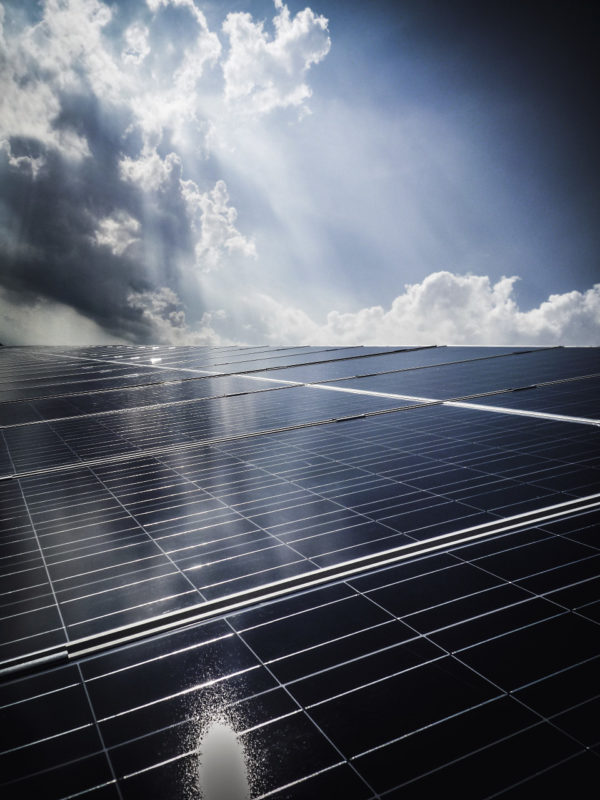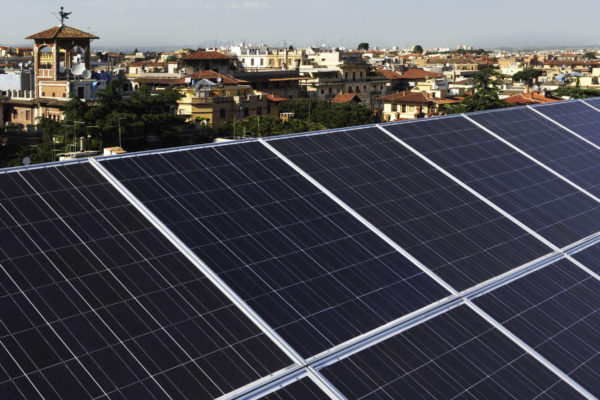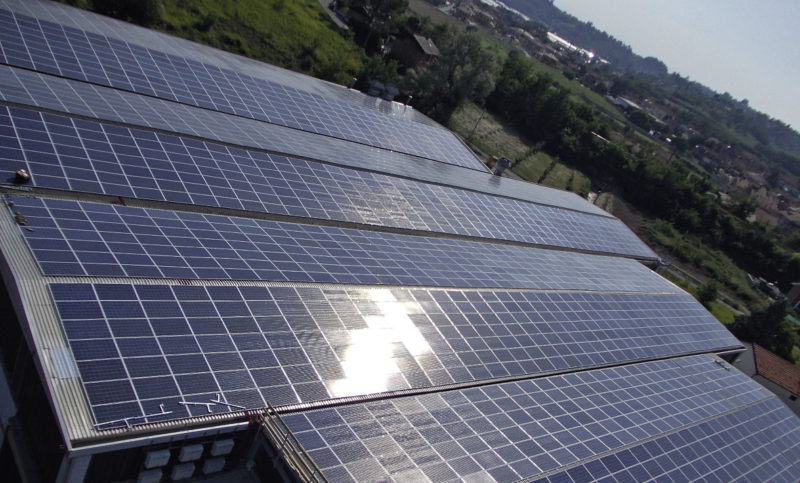Over the past three years, the Italian PV market was able to stay afloat at an average increase of between 300 MW and 350 MW in new installations per year. This growth, although very limited when compared to that of the years prior to 2013 – the year when the generous incentive scheme Conto Energia was closed – was mainly attributable to the legislation for self-consumption, which was issued by the Italian Government in 2013 and came into force at the beginning of 2014. After a first year in the testing mode, the new rules, which had initially been viewed with suspicion by the Italian renewable sector, especially because of the large number of project typologies, and the difficulty of understanding a new set of provisions (and indirect incentives) that had no proven record of success, started to provide the first results in 2015, in part as a consequence of Italy’s economic crisis, which pushed its manufacturing industry to seek lower prices for electricity.
There are two options for PV under the self-consumption scheme: net metering for PV systems up to 500 kW, and the so-called Sistemi Efficienti di Utenza (SEU) model for solar projects up to 20 MW (mostly commercial and industrial rooftop systems) with a higher self-consumption rate (possibly exceeding 70%). The main difference between the two options is that under net metering, PV systems can inject surplus power to the grid and be exempted from paying grid and system fees, while under the SEU mechanism this exemption is not granted. The exemption, however, can be granted to SEU system owners if they sell all or surplus power produced by their installations to a final client without passing through the grid, an option that is included in the regulation for self-consumption, and that has so far seen limited but increasing development in the Italian solar energy landscape. Although net metering and SEU projects for self-consumption alone were the main drivers for Italian solar over the past years, and will probably keep being the main market driver up to and beyond 2020, when Italy’s new energy strategy is expected to bring higher volumes of development, it is not excluded that SEU projects selling part or all of their power to a final client will see a larger share in the near future.
According to preliminary estimates provided to pv magazine by Italian renewable energy association ANIE Rinnovabili, which rely on data collected from the energy strategy recently issued by the Italian government, of the 30 TWh that were registered under self-consumption at the end 2015, around 73% (approximately 22 TWh) were produced by power generators qualified under the SEU model or the SEESEU model (which grants the same terms of the SEU model, but to power projects relying on mainly non-renewable energies that were authorized prior to July 2008). “It is impossible, however, for us at the moment to provide specific data on the SEU model alone, as the data provided by the government bundles data from the two project typologies into the same category. We estimate, however, that at least 23% of the 22 TWh (data collected by Italian government-run energy agency GSE) – this means around 5 TWh – may come from power generators qualified under the SEU modality,” said the secretary of the association Michelangelo Lafronza. At the end 2016, the Italian government-run energy agency GSE collected 22.000 requests (95% of SEU for PV) for a power of 7.5 GW (at least 54% SEU for PV). “The Scambio sul posto (net metering),” Lafronza went on to say, “has a share of around 2 TWh produced by 465,000 power generators.”
The SEU model
When the new regulation for self-consumption was released, Italian energy agency GSE and the energy regulator AEGGSI presented the SEU project typology as a new opportunity for renewable energy and cogeneration power producers owning power generators with a capacity of up to 20 MW to further invest in clean energy technologies. What was needed at the time was a deep knowledge of the new rules and to start gaining experience – something that took a while to be achieved. What seemed quite unclear at the early stage of the new scheme was if the option of selling all or part of the power to a single final customer was a viable one.

Image: Entec
The SEU model, in fact, apart from being the main form of self-consumption for commercial and industrial power projects, also offers the possibility for the owner of solar or renewable energy power generator to sell all or part of the produced power to a customer without paying grid, system, and dispatch charges, provided that the generator is installed in the contiguous cadastral parcels of the final client, which means an area owned or managed by the customer itself and made available to the generators until the end of 2016. Originally, the system owners had to pay only 5% of the system charges, but starting from January 2017 even this minimal percentage was eliminated.
The right contract and the right client
In order to make SEU projects bankable, the choice of the best PPA under which power will be sold to the final client is crucial, as well as the choice of the client itself. According to Emilio Sani of Italian law firm Macchi di Cellere Gangemi – which is currently following seven projects of power plants based on PPAs with industrial clients and has also assisted several Italian and international companies in the closing of private PPAs for commercial and industrial PV projects under the SEU program in Italy over the past few years – the exemption from paying the above-mentioned fees for the energy sold by PV systems connected to the medium voltage grid may result in an incentive ranging from €50 to €60/MWh, which adds to the incentive being represented by the possibility of selling excess power to the grid. On the other hand, Sani finds that the final customer may benefit from power prices in between 10 and 20% lower than those offered by traditional power providers. “The energy sold through a private PPA does not pass through the grid, and is not charged for grid and system fees, while surplus power can be sold to the grid. This facilitates long-term agreements that may even reach 10 or 15 years,” said Sani.
There are currently two main kinds of PPA associated with the SEU projects, which are the closed and open contracts. With closed PPAs, the producer sells all the energy to the customer, including both the self-consumed energy and the excess of power, with the risk concerning the amount of self-consumed energy being controlled by the consumer, while the energy which is not self-consumed shall be traded by the consumer. This mechanism is convenient, Sani stressed, if the producer intends to allocate to the customer the risk of the amount of self-consumed energy, or if the consumer intends to take advantage of net metering to inject to the grid its power surplus.
The open PPAs instead allow the producer to sell to the customer only the self-consumed energy, while the surplus power must be traded directly by the producer. The risk concerning the amount of self-consumed energy is in this case the responsibility of the producer. This mechanism has the advantage that in case of non-payment by the consumer, the producer may easily switch all the production to the grid, although not under net metering conditions, and at least obtain payment for the injected energy.
The most frequent contact typology, according to Sani, is the second one, as it mitigates risks for the power producer in the case of the wrong choice of client.
A few challenges
The main challenge for the SEU projects, on the other hand, remains the financial risk to the buyer of the energy. According to Riccardo Battisti, the Senior Project Manager in renewable energy at Italian consultancy company Ambiente Italia, the buyer may become insolvent, reduce their energy consumption, relocate their production, or even more simply change seller. Italy’s new energy strategy released in early November has also highlighted the need for new tools to mitigate these risks, although it has not provided details on how this mitigation should be achieved.
Another obstacle for the SEUs is the limitation of the power sale to only a final client. This, according to Battisti, excludes a large portion of the market represented by shopping malls, airports, industrial parks, office buildings, and multi-family houses.

If SEUs allowed offtake to more clients, in fact, it would become easier to mitigate the above-mentioned financial risks. “The SEU model is an important way to develop the PV sector, but it is important that this model evolves from ‘one-to-one’ to ‘one-to-many’ to ensure the development of renewable energy especially on multi-apartment blocks and residential areas” says Alberto Pinori, the President of Anie Rinnovabili.
Both Battisti and Sani agree that the minimum time frame of a PPA for a direct line should be around 10 years. “At the same time,” Battisti adds however, “Such a long period may increase the risks related to the possible insolvency of the buyer.”
The SEU and Conto Energia
The SEU one-to-one model represents an interesting option not only for all PV and renewable energy projects that are under the self-consumption regime, but also for those PV systems that were installed under the five FIT schemes of Conto Energia, which ran from 2005 to July 2013. These installations, in fact, are also entitled to qualify under the SEU mechanism and to sell all or part of their produced power to a single final customer. Italian solar company Entec, which specializes in this kind of project, has so far managed four projects combining SEU and Conto Energia, and has three more projects in development. “Under the current conditions offered by the SEU model, it can be more profitable for owners of PV systems installed under the Conto Energia to sell part of the energy produced by their systems to a final client, while maintaining part of the production under the feed-in tariff regime,” said the company’s engineer Elisa Ghione.
One of the company’s projects was developed by Entec in the northern Italian province of Cuneo. The installation, owned by Entec’s subsidiary Levante Srl, has a capacity of 788 kW and an expected annual production of 830,000 kWh. The project was completed under the fourth Conto Energia in August 2012 and was qualified for the SEU model in December 2014. The installation is currently selling around 300,000 kWh per year to a final client under a three year PPA. The client, for its part, has an annual power consumption of around 200,000 kWh that it takes from the grid.
Although it may seem more profitable to qualify PV systems under the SEU mechanism if they were installed under either the fourth or fifth Conto Energia – which granted lower levels of incentive – Entec has revealed that even owners of projects under the second Conto Energia, which still had very generous FITs, are converting part of their production to the SEU mechanism.
“Since the minimum prices for power sale were eliminated in 2014 and, as a consequence of the following decrease of the hourly energy prices (to around
€50/MWh), selling power to a direct client without using the grid has enabled power producers to sell electricity at prices that above €50/MWh. The client, on the other hand, has not had to pay grid and system fees, and gets electricity prices that are lower than those offered by power providers,” Ghione stresses.
Italy’s new energy strategy
On November 10, Italy’s Ministry of Economic Development issued a new energy strategy (Strategia Energetica Nazionale – SEN), which is promising to bring Italy back to the club of the world’s largest PV markets, and help push average annual growth to around 3 GW in the period 2020 – 2030. Although this is also planned for large-scale solar (starting from 2020), the Italian government made clear that self-consumption will remain one of the main drivers of the projected growth.
However, according to industry sources, the one-to-one SEU model may even stimulate growth as early as 2018 or 2019. This shows that the SEU mechanism is already doing a good job, but it also proves that further improvements such as opening the sale of power to more clients may become key for making the Italian C&I PV sector one of the main pillars of the country’s future renewable energy landscape.
This content is protected by copyright and may not be reused. If you want to cooperate with us and would like to reuse some of our content, please contact: editors@pv-magazine.com.

